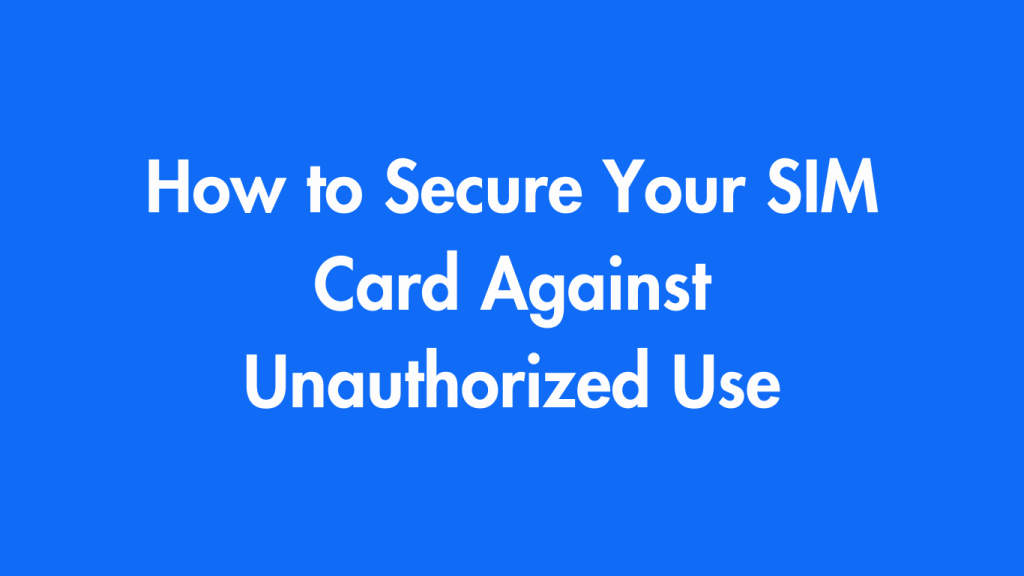In recent years, SIM swapping scams are a growing threat to mobile users around the world. SIM swapping scams can lead to financial loss, identity fraud and unauthorised access of personal accounts.
This guide provides a comprehensive explanation of SIM Swapping Fraud and practical tips to help you avoid becoming a victim.
What is SIM Swapping and Porting?
SIM swapping, also known as SIM hijacking, or SIM porting, is a form of fraud where criminals switch your mobile number with one that they control to a new SIM, bypassing security features such as two-factor verification (2FA) and gaining access to sensitive accounts, like email, social media, and banking.
SMS-based 2-factor authentication (2FA), which uses codes sent by text message, makes it easier for scammers to access financial data and empty bank accounts.
How does SIM swapping work?
Sim swapping is an attack that uses social engineering to get personal information out of people. Here is an example of the typical SIM swapping fraud:
Step 1: Collect personal information
Scammers collect information on their victims through various methods, including:
- Phishing emails and messages: Complex scams that trick victims into disclosing their personal information, such as date of birth, bank account details or mobile numbers.
- Social media: Scammers can harvest information from social media, such as birthdays, addresses, and names of family members.
- Data breaches: Scammers can access personal data through security breaches within companies or services. They could use this information to steal sensitive information and exploit leaked databases.
Step 2: Contact your mobile service provider
After a scammer collects enough personal information about their victim, they can pretend to be them by contacting their mobile service provider and claiming that their phone was lost or damaged. They will then request that the number of their target is transferred onto a brand new SIM card.
Step 3: Identity Verification Trickery
In order to verify the identity of the caller, service providers will often ask for personal details. Scammers have easy access to these data and can answer security questions correctly. They can convince service providers to approve SIM swap transactions.
Step 4: SIM Card swapping
After the victim’s SIM is deactivated, the phone will no longer work. The scammer takes full control of the victim’s number.
Step 5: Stealing information and accessing accounts
Scammers who have the victim’s mobile number can reset passwords for two-factor authentication accounts by using SMS verification codes. Fraudsters can target bank accounts, social media accounts, email accounts and cryptocurrency wallets, as well as E-commerce accounts. They may steal funds, or make fraudulent purchases with stolen credentials, or they might gain access to the accounts and lock victims out.
SIM Swapping: The Real Consequences
Scams involving SIM swapping can have serious consequences, including
- Financial Loss: Scammers can gain access to your bank account to drain funds from it, make unauthorized transactions and gain access to cryptocurrency wallets.
- Identity Theft: People may have access to their personal information, which could lead to credit fraud or identity theft.
- Social media takeover: Scammers can take over your social media account to post illegal or offensive material, or blackmail you.
- Emotional stress: The victims may experience anxiety, confusion, and frustration as they try to recover.
SIM Swapping Scams: How to Protect Yourself
It is important to take proactive steps in order to protect yourself from SIM swapping. Here are some effective safeguards.
1. Use Strong Passwords to Avoid Reusing them
Secure your online accounts by using strong passwords, which are hard to guess. Reusing passwords between accounts makes it easier to hack if one account is compromised.
2. Use Two-Factor authentication (2FA) apps
Consider using an authenticator like Google Authenticator, or Authy instead of SMS-based two factor authentication (which can be compromised by SIM swapping). These apps create time-based codes that are linked directly to your phone, making it much more difficult for fraudsters.
3. Register your PIN or password with Your Mobile Carrier
Customers can create a PIN or password to protect their accounts, which adds an extra layer of security, as scammers will need this information to change your SIM card.
4. Beware of Phishing attempts
Be cautious when you receive unsolicited emails or texts that ask for your personal information. Scammers use phishing to obtain personal data in order to swap SIM cards. Always verify the legitimacy of a communication before providing sensitive information.
5. Watch Your Phone’s Connection
This could indicate that your SIM card was swapped without your consent or knowledge. If this happens, you should contact your mobile provider immediately to determine if your number was transferred onto another SIM card without your permission.
6. Use Bank Account Alerts and Set Daily Limits
You can set up transaction alerts to be notified of any suspicious activities. Many banks also allow you to set transaction or withdrawal limits, which will reduce the potential damage if fraudsters gain entry.
7. Secure Your Information
Do not post too much information about yourself, particularly on social media. Share only the necessary information. Scammers can use this information to impersonate and commit SIM swapping fraud.
8. Your accounts can be frozen or locked now
Some mobile service providers offer their customers the option to “SIM Lock” which will prevent any changes being made to your SIM without in-person confirmation. This is an additional layer of protection from scammers trying to switch it.
What to do if you are a victim of SIM swapping
Here are some immediate steps to take if you suspect you have been a victim of a SIM Swapping Scam:
Call Your Mobile Service Provider Immediately: You must immediately contact your mobile service provider to explain the situation. You can ask them to disable any fake SIM cards and then transfer your number back onto the original SIM.
Change passwords for all accounts: Change passwords for all accounts that are connected to your mobile number. This includes emails, bank accounts, social media profiles, and online shopping sites.
Contact your bank: Inform any financial institution about any fraudulent activities to avoid their account being frozen, and to monitor suspicious transactions.
Report to Authorities: File a formal complaint at your local police station or cybercrime department, as well as using the Indian Cyber Crime Reporting Portal https://cybercrime.gov.in to report fraudsters.
Monitor your Accounts: Always keep an eye on all of your accounts and services, including emails and sensitive ones, for suspicious logins or transactions that could indicate fraud. If you discover any suspicious activity, report it immediately.
Conclusion
SIM swapping frauds are a growing threat in our connected world. By being proactive and aware of the risks, you can lessen your chances of falling victim. To protect your account, use strong passwords and enable two-factor authenticator apps. You can also work with your mobile provider to secure your account. If you are the victim of a SIM swap attempt and your personal information has been compromised, acting quickly can protect privacy and minimize damage. Be vigilant and guarding your mobile identity will prevent fraud and identity theft.


